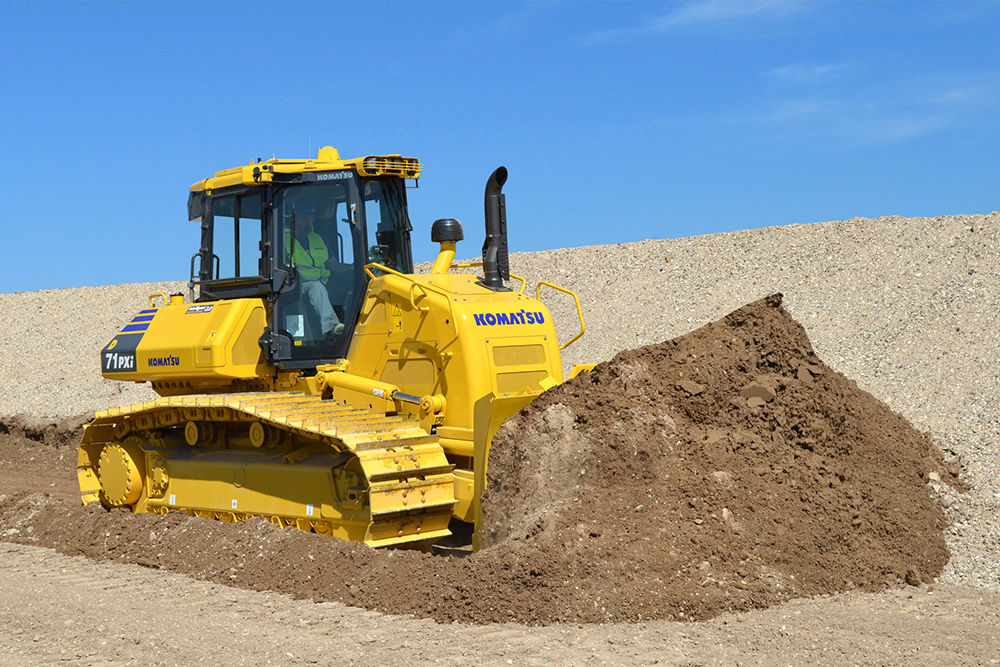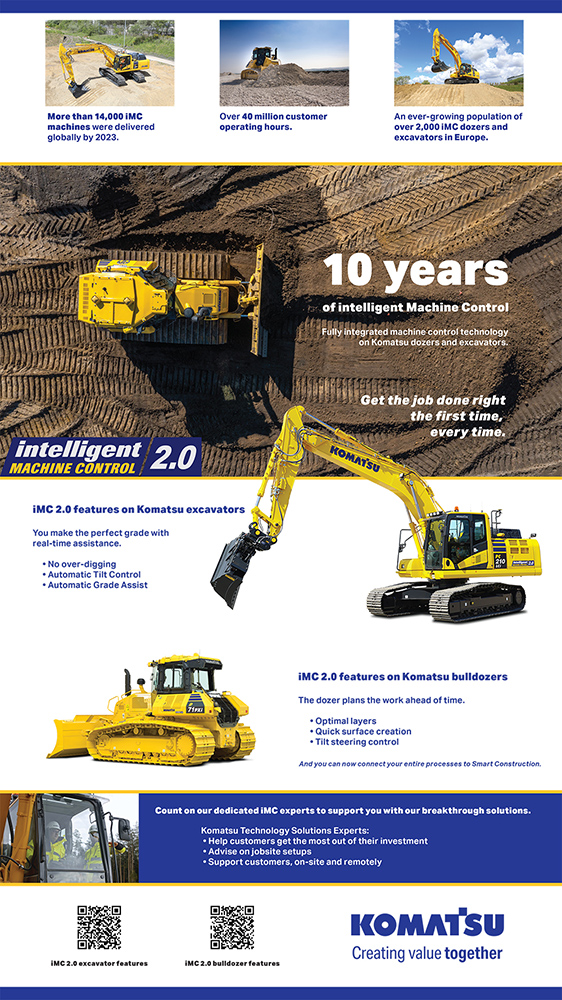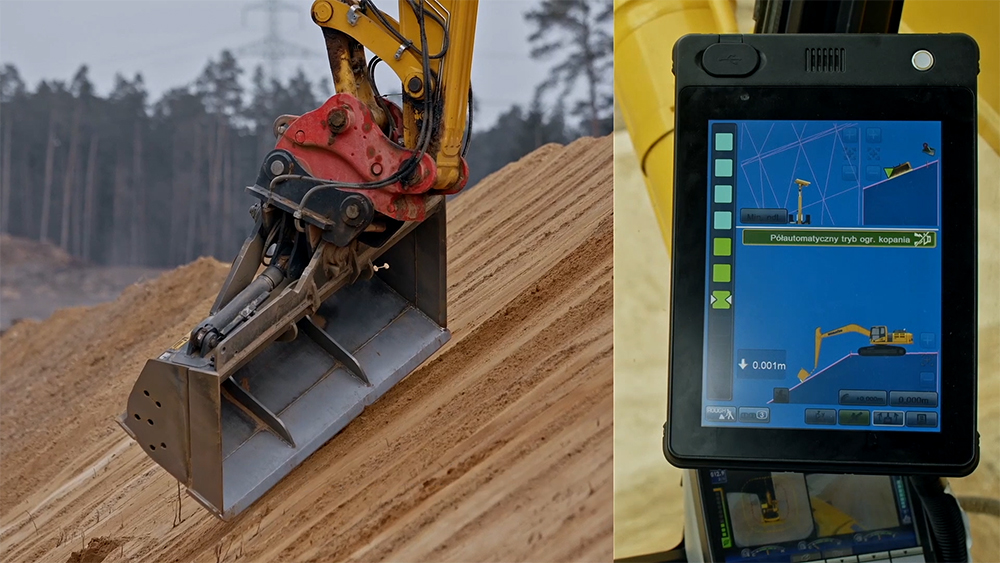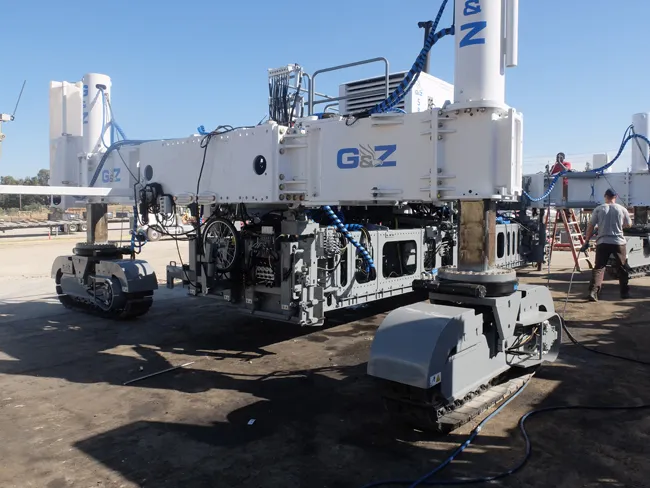
When it was introduced to the market, firstly on bulldozers, in 2013, and then on excavators, in 2014, Komatsu’s fully integrated intelligent machine control (iMC) system took the construction industry by storm with unique assist features for the operator, which fed through to massive productivity, efficiency and cost saving gains for customers in their earthmoving operations. It also brought major safety benefits to jobsites, by eliminating the need for grade-checkers or surveyors to be in dangerous areas around the machine.
 Now, 10 years on, Komatsu are celebrating a decade of intelligent machine control, with a worldwide population of over 14,000 iMC equipped machines, that have clocked up over 40 Million operating hours of value for their owners and operators.
Now, 10 years on, Komatsu are celebrating a decade of intelligent machine control, with a worldwide population of over 14,000 iMC equipped machines, that have clocked up over 40 Million operating hours of value for their owners and operators.
Every one of these machines has the iMC technology built-in at Komatsu’s factories, meaning the integrity of the system is ensured by the same, exact quality controls. This ensures the robustness of the technology matches the base machine, a fact borne out by this large, ever growing and field-proven population.

 In the development stage of intelligent machine control, Komatsu leveraged machine operational data from sources like their telematics system, Komtrax, and combined this with the deep jobsite and application expertise of their field and distributor staff. This constant learning didn’t stop after launch, and a huge amount of experience and feedback was gained in the early years of market introduction, as customers deployed iMC on their jobsites, supported by Komatsu and its distributors resulting in constant refinements of the machine/operator, technology, product support functions and interfaces. Looking back over the last 10 years, this activity has really paid off in a highly experienced support network extending from the distributor Technology Solutions Experts right through the whole Komatsu service and technical organisation, ideally placed to assist customers who are new to machine control and to ensure they experience the iMC benefits, and return on their investment, quickly and seamlessly.
In the development stage of intelligent machine control, Komatsu leveraged machine operational data from sources like their telematics system, Komtrax, and combined this with the deep jobsite and application expertise of their field and distributor staff. This constant learning didn’t stop after launch, and a huge amount of experience and feedback was gained in the early years of market introduction, as customers deployed iMC on their jobsites, supported by Komatsu and its distributors resulting in constant refinements of the machine/operator, technology, product support functions and interfaces. Looking back over the last 10 years, this activity has really paid off in a highly experienced support network extending from the distributor Technology Solutions Experts right through the whole Komatsu service and technical organisation, ideally placed to assist customers who are new to machine control and to ensure they experience the iMC benefits, and return on their investment, quickly and seamlessly.
This continual development also delivered on the product side, with the introduction of intelligent Machine Control 2.0 (iMC 2.0) and an expanded range of excavators and dozers in 2020 and 2021.
 The new iMC 2.0 features provide even more assistance for the operator, by controlling tilt bucket adjustment to match grade on the excavator, or automating the spreading of pre-defined layers of material by the dozer blade, for example. This helps inexperienced operators gain confidence and deliver high productivity quickly, and also complements highly experienced operators’ skills by allowing them to concentrate on moving material, rather than being focused on avoiding mistakes inherent in guidance only systems.
The new iMC 2.0 features provide even more assistance for the operator, by controlling tilt bucket adjustment to match grade on the excavator, or automating the spreading of pre-defined layers of material by the dozer blade, for example. This helps inexperienced operators gain confidence and deliver high productivity quickly, and also complements highly experienced operators’ skills by allowing them to concentrate on moving material, rather than being focused on avoiding mistakes inherent in guidance only systems.
Komatsu’s continuous dedication to consistently enhancing customer value is not only achieved through hardware advancements but also via significant improvements in software capabilities. Among these is the introduction of an automated data-capture feature to their iMC technology. Regardless of the machine's model or age, all units can now autonomously gather location and elevation data from dozer tracks and bucket edges. The collected data can then be consolidated and visualised on Smart Construction Dashboard, a 3D visualisation tool introduced by Komatsu, enabling customers to monitor volume-based work progress at their job sites directly from their desks, with updates available on a daily basis.
 Over the last decade, customers’ adoption of iMC technology has significantly changed the conventional way of working on construction jobsites. Recognising the growing need for swift and reliable support for 3D technology, Komatsu introduced Smart Construction Remote, a software that is specifically designed to bridge the gap between the field and the office. With Remote, design changes can be executed instantly on machinery in the field, and operators can receive rapid expert support from Komatsu-trained professionals by simply sharing the screen. Today, Smart Construction Remote connects over 700 machines on jobsites to offices, saving thousands of hours previously spent by jobsite managers, surveyors and engineers commuting from offices to jobsites.
Over the last decade, customers’ adoption of iMC technology has significantly changed the conventional way of working on construction jobsites. Recognising the growing need for swift and reliable support for 3D technology, Komatsu introduced Smart Construction Remote, a software that is specifically designed to bridge the gap between the field and the office. With Remote, design changes can be executed instantly on machinery in the field, and operators can receive rapid expert support from Komatsu-trained professionals by simply sharing the screen. Today, Smart Construction Remote connects over 700 machines on jobsites to offices, saving thousands of hours previously spent by jobsite managers, surveyors and engineers commuting from offices to jobsites.
So to summarise, the first 10 years of Komatsu’s intelligent machine control have been marked by a decade of unique innovation, continual learning and development with customers. Komatsu’s desire to deliver even more value creating technology to the jobsite will ensure this journey continues. Here’s to the next ten years!
Content produced in association with Komatsu








